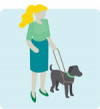Designing for universal access means accounting for humans, in all of their varied capabilities and states.
The following principles of Safe, Obvious and Step-free (SOS) incorporate human variation, so that planners and designers can incorporate universal access into their projects. It is important that safe, obvious, step-free routes are provided as a priority on the most important pedestrian routes in towns and cities.
Safe
Pedestrians are safe from harm. They feel safe and comfortable in environments that have:
- safe speeds where pedestrians and vehicles can conflict: collisions are survivable if someone makes a mistake
- separation: pedestrians are separated from faster modes
- sufficient width to allow users to pass each other
- non-slip surfaces: surfaces are not slippery or in need of maintenance
- no hazards: routes are free from obstacles and trip hazards
- good lighting: all public space and walkways are well-lit
- public surveillance: public spaces and walkways are located in places where they are visible by the public.
PNG: Relationship to speed and speed environment

People regularly grab me in public, usually trying to be helpful but it is so disconcerting I avoid places that make me feel even more unsafe, particularly at night. I like to know there are other people around and that places are well-lit, even though I cannot see. I am definitely more likely to walk in some places than others, based on how safe I feel from the risk of being attacked.
Layla
|
Obvious
Routes and wayfinding are clear for all people when:
- affordable, accessible transport choices are available
- there are clearly marked pedestrian-priority routes along paths and streets, through public spaces and across roads.
- routes are navigable: wayfinding information is –
- provided in digital, paper, and on-street formats
- visual, tactile, and audible
- consistent within and between towns, cities, and across New Zealand
- pedestrians, bicycles, other mobility devices, cars, buses and trucks each have their own space or are clearly excluded.

If something doesn't feel familiar or if I am not sure which way to go, I can panic and freeze, and I can't talk to people when that happens. So I stick to the most obvious walking routes.
Josh
|
Step-free
Step-free route choices are available. They are easy to find and navigate when:
- smooth step-free, obstacle-free ways to navigate through spaces and to access public spaces and buildings exist
- safe and obvious (that is, they do not involve excessive diversions, or require people to put themselves in danger to avoid a step)
- step-free routes can be negotiated independently
- routes have gentle gradients and places to rest (for example, landings on ramps).